Recently in our HowToPastel Facebook group, I read this question:
“I’m a beginner and I am starting to gather the needed materials. Do I need an easel and what would you recommend?” (Thanks Dolores M!)
And my answer is…
Heck yes!!!
Okay, you may be asking, WHY do I need an easel Gail? And specifically, why do I need a standing easel (rather than a table easel)?
Let me list the reasons!
Reasons to use an easel
1.If you work flat i.e. without an easel, pastel dust will accumulate on the surface of your piece as you work. You’ll want to get rid of the dust because, for one thing, you won’t be able to see your emerging piece and also, it will just get plain annoying. And so, gasp, you will be tempted to blow the dust away! Say whaaaaat? That’s just a plain ole No-No!!
Pastels are pretty benign…except for inhaling the dust – that’s definitely not a good thing! You get the connection, right? Working flat leads to dust accumulation leads to taking the easy route and blowing your piece to get rid of the dust. (Better would be to walk outside and tap the board to get rid of the loose dust).
Working on an easel means the dust falls from the piece as you work. The best is to have the easel tilted slightly towards you (you won’t even notice) because then the dust falls to the tray, and doesn’t slip and slide over and onto the piece itself.

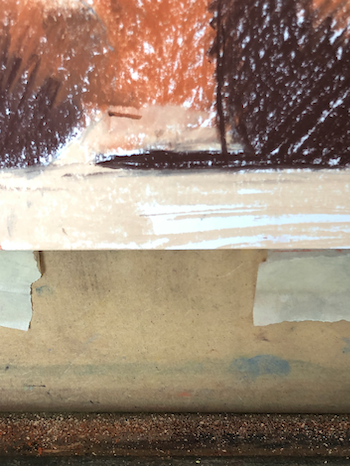
2. An easel allows you to move away from your work often and effortlessly. Why is this a big deal? You can see the work from a distance. This shows you what many viewers will see AND it helps you to avoid being consumed by the details and the micro-moments of strokes! Step away and have a look. This also helps with making immediate judgments of your work.
3. Working on an easel means that you have more available arm movement. Working on a board on your lap or flat on a table, you can only work from your hand to elbow. It’s pretty much impossible to move from your shoulder and use your whole arm. More range of motion means more dynamism and looser, expressive strokes.
4. If you’re working from life, it’s easier for your eyes to move from subject to painting and back to the subject.
5. It helps avoid distortion in your work. Imagine you’re working at a piece on the table. Can you see how you aren’t looking at the piece square-on? This can lead to some skewy paintings! A piece on an easel means you are looking at it straight on.
6. If you work flat, there’s more chance of you smudging the piece with another part of your arm, particularly if you’re wearing loose clothing. This won’t happen working upright.
7. Working flat may make it more difficult to have a lighter touch which, as you know, is so important when it comes to layering pastels.
8. Work-in-progress on an easel is actually being stored. It’s generally out of harm’s way and also means you don’t have to spend time wrapping it up and finding a safe place for it between sessions.
9. You’re likely not working in your own shadow.
10. Working at an easel keeps you moving which as we all know, is healthier than sitting for long periods of time!

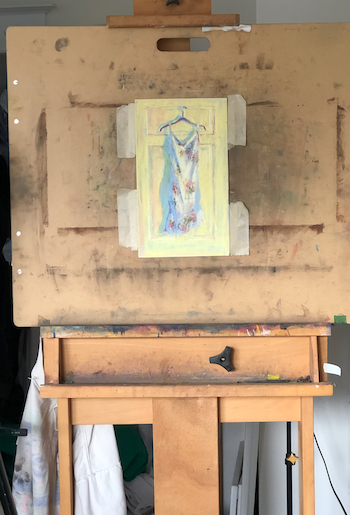
Now that you’ve been convinced you should have an easel (you have right?), let’s look at some things to consider when purchasing.
What to look for in an easel for your studio
1.If at all possible (space and budget-wise) go for a four-legged version aka H-frame rather than a three-legged aka A-Frame. The H-frame is a much stronger, less wobbly option.
2. It should be easily maneuverable. What do I mean by that? Anything that slides, turns, pushes, or pulls you should be able to move easily without assistance.
3. The easel should have enough height. This is particularly true if you are tall. The part that supports your board or canvas should be able to move high enough so that your art piece is easily at eye level.
4. Tiltability. The easel should be able to tilt forward slightly off vertical. This will allow pastel dust to drop directly into the tray rather than skimming over your piece on the way down.
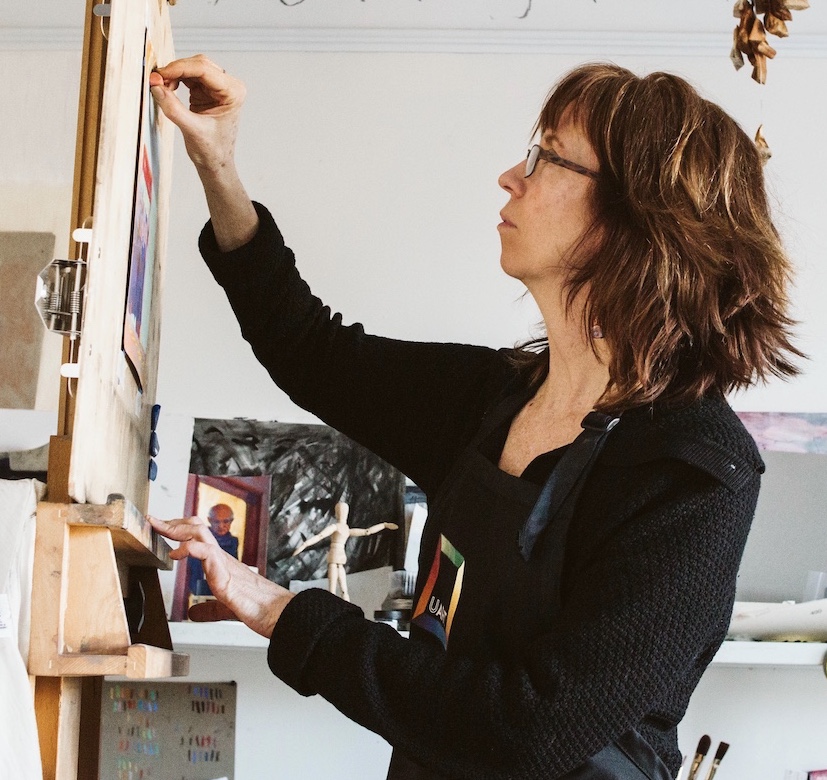
5. Make sure the top clamp is removable. I have seen easels where they are not!
6. Is it large enough? If you plan on working large make sure the easel can support a larger board or canvas.
7. If it has wheels, make sure they are the locking kind. An easel on the move would be as bad as or worse than one that was wobbly!
8. Try not to get sucked into unnecessary features. Be clear in your mind about how you want to use the easel.
I think that’s it!
Have I missed anything?
Good easels are not inexpensive. I’d suggest deciding on one and then looking for it to come on sale. But don’t wait too long. If you can’t wait, bite the bullet and purchase! A good easel will last for years and be enormously helpful. I can’t imagine being without mine!!
By the way, if you’re not comfortable standing for long periods of time, I still encourage you to get a standing easel. And then get a tall stool. You can sit on the stool at your easel but easily slip off it to step back from your piece. It’s also easy to move a stool out of the way if you want to do some standing work e.g. to make some broad, bold strokes.
Do you use an easel? If so, what’s the best thing about your easel? If you don’t use an easel, let us know why and also if you’ve been inched closer to getting one! You know how I LOVE getting comments!
Until next time,
~ Gail
PS. My beloved Thompson Easel!











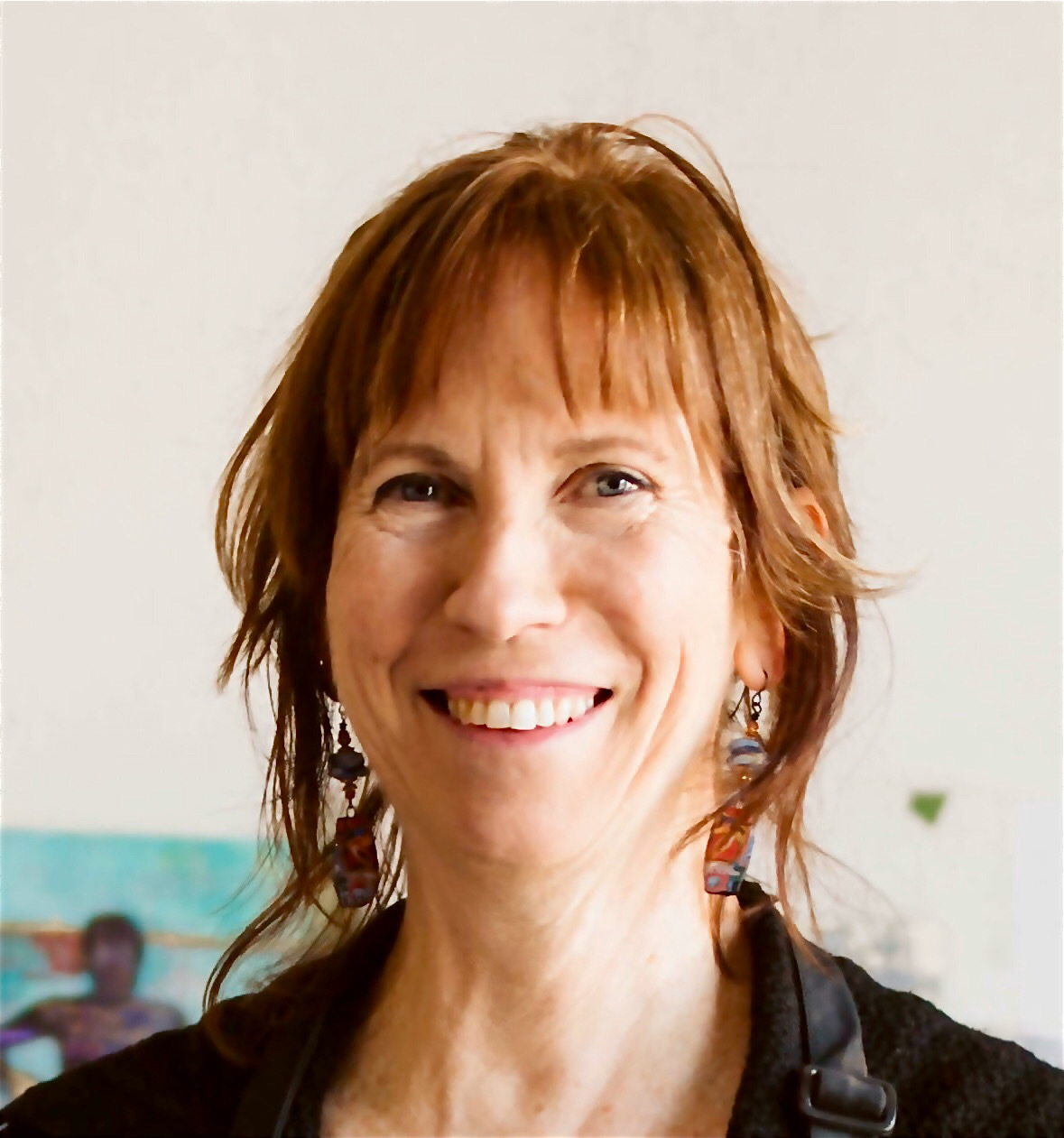

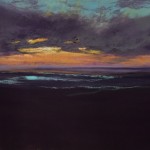
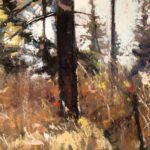
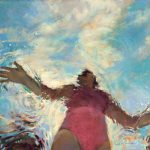
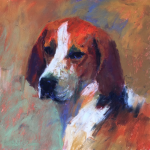




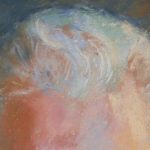
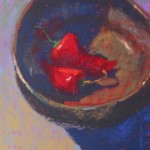

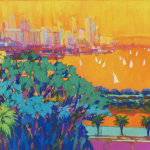
![Pastels on black aper: Gail Sibley, "Untitled [at this point], Mount Vision pastels on Sansfix pastel card, 5 1/2 x 7 3/4 in](https://www.howtopastel.com/wp-content/uploads/2016/04/IMG_9649-2-150x150.jpeg)

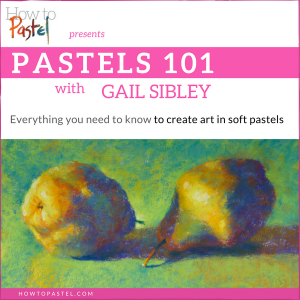

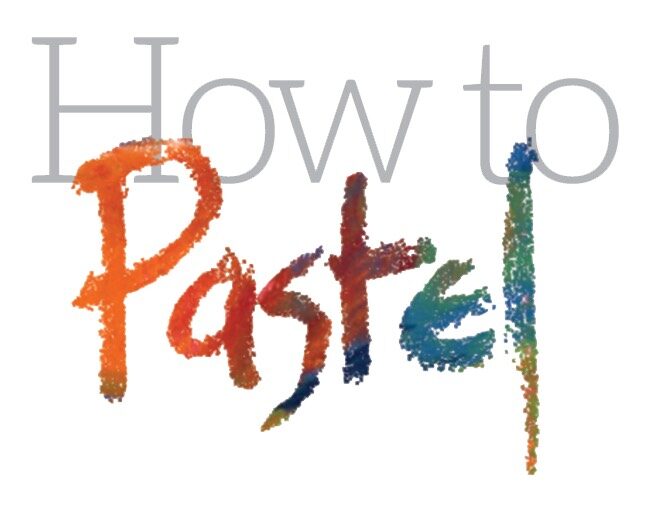

46 thoughts on “Do You Need An Easel?”
Hi Gail – great article – agree with you totally! I love working at an easel – using a lyre easel in my little studio as I have limited space and a lightweight folding aluminium one for working outdoors.
Yay Penny! And yes, if space is limited, a lyre easel (A-frame) definitely takes up less room.
And I didn’t even touch on easels for working outdoors! Thanks for sharing what you use.
Totally agree with you on needing to work on an easel. You mentioned avoiding breathing in the pastel dust but I noticed in the photograph of you working at your easel that the work is above your nose height so there is a danger of you breathing in falling dust. I always have the top of work at eye level .
Glad you agree Jeanette regarding an easel.
I think the photo may exaggerate the angle a bit but that’s a good point about the possibility of breathing dust as it falls. I have to say though that I am very careful about fast movements and never have open windows etc when I’m working.
Thanks for bringing this point to our attention!
Yes. Absolutely. I agree with everything you say about easels. I used to occasionally take a table easel when I was traveling and really noticed the difference in my work. And not in a good way!
Pamela, I’m glad you shared your experience trying a table easel when you travel and how much (negative) difference it made.
When I’m super limited with space when travelling, I only take a board which I juggle on my lap en plein air. Otherwise, I definitely take a standing easel!
Hello fellow pastel artists. I am mostly a plein air painter and don’t use an easel. I have a light weight chair and flat table to put my pastel case on. Then I hold my paper at an angle resting on the table. Maybe it is not the most efficient way. I have an easel to add to my Heilman Pastel Box but it is limited to a straight up 90 degree angle. I didn’t like that. I like my system but I usually work small 8 by 10 inches. Any suggestions of an easel that tips at various angles? Thanks.
Nancy, thanks for chiming in on the easel question. I think if you’ve found something that works for you when painting outdoors, then stick with it.
As to your question, I use the MABEF Tripod Field Easel as it does tilt forward. If you’re in the USA, it’s available from Dakota Pastels.
I used to do my drawings on a flat surface (before I started pastels) and was taught by my first instructor (and mentor/friend) that I really needed to use an easel and she explained why. How my drawings can be out of perspective because of the angle I was viewing them from. With drawing, she said at the very least use a drawing board held up at an angle toward you. I got an easel. It was hard to get used to at first as I was so used to drawing flat, but now I can’t do without it!!! My first easel was an A frame and I liked it well enough, but later had problems with it that lead me to an H frame by MABEF. I like it a lot so far!! Pastel painting requires an easel in my humble opinion. Just for the wonderful reasons you mentioned!!
Hey Kathryn, thanks for sharing your journey into easel-dom!
MAFEB does make marvellous easels so I’m delighted you mentioned them here.
And you’re right, if you’re used to working flat, working upright can take some getting used to but as you’ve pointed out, it’s sooooo worth it. A big thank you to your first instructor!
Hi Gail, I’m Shopping and am sure to find a used one on Salt Spring. Sandy
Hah hah!! That’s great to know Sandy 🙂
Years ago, I used a drawing board in my lap leaned up against a table which put the work surface at an angle. It was way better than working laying flat on a table. It stopped the keystoning effect because it put the work surface parallel to my eye. However, it did leave me with the dust sliding down my work onto my lap. I was able to get a nice rolling/lockable easel that fits me nicely and I cannot imagine working without it. A good easel is well worth the money and can be had for a worth the money if you watch the sales. I am not prone to spending money willy nilly but an easel is a great investment in your work, back, and comfort. 😀
Thanks Marie for sharing your easel journey. I smiled at your dilemma of pastel dust sliding into your lap as you worked – been there, done that! (And still do on occasion when I end up without an easel painting outdoors.) I’m so glad you found an easel that suits you – so important! And thank you for confirming that a good easel is a worthwhile investment!
I never knew an easel should be slightly tilted TOWARDS you – mine has always been tilted slightly away from me. Doh! Thanks Gail.
Hah hah – it’s the little things that can make a BIG difference Jan! And now you know 😁
I have a wonderful H frame that I bought for color pencil work. Now I mainly work in pastel and, unfortunately, my wonderful easel does not tilt forward. Someday I’ll spend the money again. Live and learn!
Ahhh Tamara, I’m sorry to hear that especially since the easel you have is so great. Live and learn indeed.
I just purchased a Take it Easel for taking outdoors for painting. It is so sturdy and easy to use! Indoors it is wonderful too, but I realized how huge a footprint it takes. It is STRONG. I can hang my bag on it, and all the pastels set up beautifully on a board that I take with my drawing board. If you had a pastel travel box, it would work great too without the shelf board. But I have my pastels in smaller bins that stack nicely in a lunch box, so that is why I need a shelf along with my drawing board. I take a cross beam with me that packs up with the easel well to mount over the pegs, so I can take a smaller drawing board. The wood is smooth and fine grain. A pleasure to touch. The hardware is smooth and a breeze to take up and down quickly. It is NOT lightweight, but the shoulder strap is comfy. Use indoors would not be friendly if at a workshop, unless it was helping you keep social distancing. :).
Sue, that’s for your in-depth and very positive review of the Take It Easel (which I have linked to if anyone is interested). But of my goodness, I see what you mean about the footprint! Of course, that’s what makes it so stable! So yes, not for indoor work. 😜
Ah the easel conundrum. I am using a cheap michaels a frame placed on a small office table which has a slider shelf underneath. I purchased a Mabef mini field easel but since I am inept at assembly it’s not used. Also purchased Heilman box and easel which I love for portability. But got the me-foto tripod to attach for plein air and can’t figure it out. Will be going to photo store soon for assistance as weather improves. It’s crazy but vital to use. Also use a stool for taking the weight off!
Hey Brenda, I have the MABEF Mini field easel too and I understand why you may not have assembled it yet. I was flummoxed the first couple of times. In fact, I needed to watch the video to understand how to put it together! Click here for the video I watched.One thing is, I wish they’d added de-assembling the easel to the video!! My suggestion is to take block off some time to assemble, then disassemble, then assemble again, then again, disassemble. Repeat this at least one more time. Then the next day, assemble and disassemble. And repeat again over the next few days. This will start to make it so easy to assemble! It’s a good easel so I encourage you to get it out!
And you also have the Heilman box with tripod! Glad you are headed to the photo store to get some help. You have such good easel tools!!
And yay to the stool!
Hi Gail thanks for the comment. I did watch the video after purchasing the mabef, had it up once in my living room and took it down to take to a workshop. Glad I brought a plan b lol. I will likely stick to the Hellman and sure hope I can get the tripod thing tougher. I don’t have the time to do as you suggest, but it is excellent advise as repetition is the best way to learn! Maximum 20 months to retirement from med and just trying to hold it together, short of help, training new hires whilst getting the work done its I wonder I’ve kept my sanity thus far!
Brenda, you are doing GREAT!! Hang in their girl!!!
And do come into the IGNITE! community and let us know how things are going for you.
My “art room” (can hardly call it a studio!) is a small spare bedroom — with a light beige carpet!! The carpet was new all through upstairs when we bought the house, and we don’t want to do anything to it because we won’t be living her forever….so, I have to be VERY CAREFUL and therefore use a table easel. I did pick up a good A-frame easel used — but then when I tried to put it up at the right angle to use in this small room, it scraped the ceiling! And I can’t move it down much more….so, just a word of caution to those buying an easel — measure your ceiling in the space you’ll be working in! My only solution is to get up frequently in order to get back from the easel, but so far, that’s my only workaround for inside. Outside, I use a Heilman pastel box with the easel attachment that fits onto it, and I mount the box to a tripod — works great, fits in my backpack, easy to transport!
Paula, it’s wonderful that you have your own space for your art! Regarding the carpet, I can suggest two options:
1) cover the whole area with a sheet of painter’s drop cloth (the heavy material NOT plastic!!).
2) get a piece of remainder carpet and put over top of the good carpet.
Both these options will protect the original carpet and allow you to have a standing easel.
You mention a valid problem that I was going to mention in my list but somehow missed. I will add it now. It happened to me!
And thanks for sharing your plein air set up!
Thanks Gail. I couldn’t imagine painting without an easel, and always surprised by the number of people at life drawing who want to use tables. I bought my Mabef A frame easel a few years ago when I started oil painting- also bought another Plein air variety (after buying some cheap portable ones that fell over and collapsed in the middle of a drawing session). I didn’t know about the forward tilt because it always seemed more natural to tilt it slightly backwards – but then the pastel gets all over the painting, as you say. One thing – you seem to have your painting very high on the easel and to be reaching up to paint (I have mine lower, but almost always stand at it). Is there any reason to have the painting at this height? Will it turn me into as wonderful artist as you?? (LOL)
Ahhhh another MABEF owner! They are good easels aren’t they?!
The tilt backwards works for most other types of painting but certainly helps with pastels!
Regarding the height of my piece, the angle of the photo exaggerates what you’re seeing. Generally, I place the middle of the piece at about eye level. I often spend time adjusting my piece to the right height. I don’t like it too low as I feel cramped somehow, with limited arm movement. I think you need to find the height that works for you. And hah hah, I don’t know if this will make you a better artist but who knows?!
Please talk more about tabletop easels. Are any of them good to work with ?
Thanks
Jenny
Jenny, I actually don’t know anything about table easels as I am an advocate of a standing easel for the reasons I mention in my post. Perhaps there are some readers who will respond to your question. I hope so!
Definitely, if the only options are a table easel or working flat, the table easel wins! I haven’t yet come across one that tilts forward. Like I say though, I don’t have much experience with them. I only can reference the odd class I’ve given where students bring them to work on.
Thanks for your comments. I haven’t seen one that leans forward.
I hope some here has some suggestions, but maybe I should reconsider.
Jenny
Definitely have a rethink on easels Jenny. Standing makes a huge difference! And definitely consider a tall stool that can relieve standing but allow you to easily slip on and off.
Hi Jenny, I use a cheap michaels metal a frame that is adjustable from table top to stand alone. I would never use it as a stand alone as its too light, but placed on a table or office desk, as i use, near the edge you can stand or use a stool, as i also use, and it works great for me. When i attended drawing classes at Cambridge CCAE we sat at tables with large boards that slanted . Altho the instructors there were awesome, I don’t think sitting is the better mechanic for full body use and observation as Gail supports!
Thanks Brenda for sharing your thoughts and info!
Great article, and timely. I am just about ready to do an easel set up in my studio.
Until now, I have variously held the board in my lap, or laid it on a tabletop. More recently I have used a wonderfully simple rectangular table easel, but I’ve been wanting to get a standing easel for ease of body movement.
I’m considering mounting a 20″x30″ board on my studio wall. I would accomplish the recommended tilt toward me by putting a 1″x2″ board horizontally behind the top of the board. I would build (or buy) a removable dust bin for the bottom of the board.
Any thoughts?
I think your idea would work well Liz. You might consider installing an even larger board that will accommodate one large piece or two smaller pieces. And I like your clever tilt idea 😀
Also, do get a large piece of remainder carpet or something along those lines, say 6 x 6 ft, to cushion your feet AND any falling pastels.
Good article! I used to have a simple table top easel that I would place on my desk in front of the computer screen, on which would be the original photo. I bought it after I realized that drawing on the desk top skewed perspective. I could either sit or stand, however I felt better at attacking it. But something happened to it, and now I use an H-frame table top easel that my daughter had. The problem for me is that this holds the board higher up than my old one, and I have to exclusively stand at my desk to use it. Still, it’s fine for me at this time, since my reference photo is always on the computer, which is on my desk, and my study is too small to keep a regular sized easel (my wallet to buy one, too). Some day in the future (when I win a little lottery) I will buy a standing easel that I can dismantle easily, and a tablet to store my photos, along with a contraption to hang it on the easel.
Thanks for sharing your experiences with easels Maria. It’s tricky finding what works best and which easel will fit our space and budget. I would hope you could find a standing easel that you can leave up. A small plein air easel might do the trick! And yes to a contraption to hold the tablet. I recently got one (recommended by Richard McKinley) and it works like a dream. It attaches to your board. It doesn’t appear to be available any longer but click here to see a comparable one! They aren’t expensive and make a world of difference!!
This is the one I bought. It seems to work well.
Great Terri!!
Hi, Gail,
I struggle with where to paint in my home. The only place I can without getting pastel dust everywhere we use is the unfinished basement with 1 or 2 of those tiny, high basement windows. Do you have any suggestions for adding light and setting up a studio in an ugly space? It is so depressing and uninspiring, I seldom paint even though I love pastels. I do paint plein air sometimes, but want to be able to paint in my home and cannot rent a studio at this time.
Hi Beth, thanks for your question! It’s so difficult at times to find a place of our own to paint. It’s especially great when we have a space where we can leave work and supplies out, and not have to put them away at the end of each painting session.
An unfinished basement sounds like a place of promise and possibility. Is there are least drywall or a finish (ie not just studs and covered insulation)? If so, I would paint the place a bright white so that any light will be reflected around the room. I would also surround yourself with anything that brings you joy – a rug, flowers, books, a comfy chair. It’s great to make the space yours, a place you want to be. I’d say create a studio sanctuary!
As to lighting, I’m not sure what electrical you have set up. If you can add overhead daylight tube lighting, that would be great. In an earlier studio, I had a daylight bulb light set up that I could plug in. I couldn’t have painted without it! Maybe others will have some ideas for you 😁
Hi Gail, thanks for all your good info on easels. Unfortunately, I am unable to afford a good easel. I have one that is a tripod – not very good. Also have a table easel – slightly better. I have my eye out for a used one, but don’t know where to look. Any suggestions? I live in Fresno, CA.
Gay, I’m glad that you have an eye out for a used easel. Idea would be to check with different art associations and colleges/universities. Also, art societies may have newsletters that may have things for sale. And what about putting out a request on Craigslist? Or a local equivalent? I know you’ll find one!!
Hi Gail, I’m new to pastels (5 months) and received my first H-frame easel as a Christmas Gift. The easel I requested and received was the Blick brand Medium Duty H-frame easel. In my opinion it was a great value. I’m in the US and it cost $150-160 with free shipping on sale. It was an easel Karen Margulis recommended and I’m thrilled to have it. I’m in the process of moving all my pastel supplies and painting to one end of my weaving studio where I have wonderful light. This easel has a smaller footprint and will incorporate well into my allotted space. I would recommend to US followers who are on a budget.
That’s awesome to hear Carol Ann! It’s always great to hear about specific recommendations. Here’s a link for anyone interested!